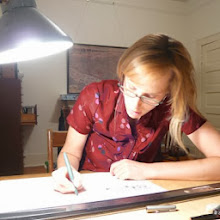At the brief presentation for the Pelliccia and Nix fellowship work this afternoon at the University of Virginia School of Architecture, I hope to convey my thoughts on Drawing. Beyond my specific research questions, this is what I learned:
I proposed drawing studies at two different, seemingly unconnected, scales: The birds' eye view and the more intimate scale of buildings and outdoor "rooms" like piazze. I appreciated navigating and drawing the nooks and paths of the city during the day, then climbing the Monte Gianicolo in the early evening as the sun cast its highlights over the architecture of Rome and trying to draw what I saw, the view from the Gianicolo. I was attempting to understand how Tempesta and Vasi were able to create such rich cityscapes in their Views of Rome - such detail in individual buildings, showing the city as a complex organism, blocks as organs, streets as arteries and veins. As I strained my eyes and tried to transform vision into drawing, like feeding a star through a sieve, I could trace my routes of the day throughout the city, from places I'd drawn and absorbed or lingered over or rushed through.
In the eddy of contemplation, and a little more research, what I learned was that, between my two disparate drawing programs, one [experiential drawing] was the answer to the other [the process of constructing a comprehensive, detailed, yet impossible view of the city.] I learned that intimate knowledge, the kind gained from walking and drawing and looking and lingering, was necessary for the makers of Renaissance and Baroque Views of Rome. I believe they relied on triangulation, measurements, and mathematics, street and block plans like Nolli perfected, views from multiple high points around the city. But it was the knowing, walking the streets, that was the key to fabricating the amazing impossible view.
In the eddy of contemplation, and a little more research, what I learned was that, between my two disparate drawing programs, one [experiential drawing] was the answer to the other [the process of constructing a comprehensive, detailed, yet impossible view of the city.] I learned that intimate knowledge, the kind gained from walking and drawing and looking and lingering, was necessary for the makers of Renaissance and Baroque Views of Rome. I believe they relied on triangulation, measurements, and mathematics, street and block plans like Nolli perfected, views from multiple high points around the city. But it was the knowing, walking the streets, that was the key to fabricating the amazing impossible view.
The same kind of knowledge aids architects,
today. It is achieved, not by digital means, though these are spectacular analytical
tools, but by hand. The confluence of drawing and presence. Drawing a space –
whether a building or a view – is the only way I can arrive at the sense that I
have experienced it, that I know it. And physically being in a space while
drawing it. Seeing, feeling, hearing, smelling, tasting it. That may seem
abstract, but this sensory, temporal and spatial abstraction is precisely what
drawing can achieve. I try to combine and conflate these senses in creating an
experiential drawing by which I can record my experience of coming to know a
space through drawing.
I can photograph every inch of it, but only the drawing – both the conscious act of eye to mind to hand (to eye to mind to hand) and the capacity of drawing to twist, splay, point, unfold, converge and overlay perceptions, time and space - allows me to understand the structure, volume, materials, density, permeability, renewal, decay, verve of a place. Through drawing it, I attempt to devour it and it always devours me. It is exhausting and exhilarating. Only through this tug of war, can I really see the place. Likewise, I can look at every bird's eye view and read every text, but it is in the acting that I begin to understand the process of creating. Perhaps this 'third' dimension of research, acting, is the best 'primary source' in studying history of drawing processes.
 |
| Drawing the impossible (bird's eye view) from the Gianicolo [How did Giuseppe Vasi do it in 1765?] |
 |
| Drawing within the city, spaces shaped by walls. Experiential drawing. |
 |
| a few finishing touches at pin-up |









1 comment:
Just a wonderful viewpoint, K! Wish I could have heard the presentation. They definitely picked the right person for the project :)
Post a Comment